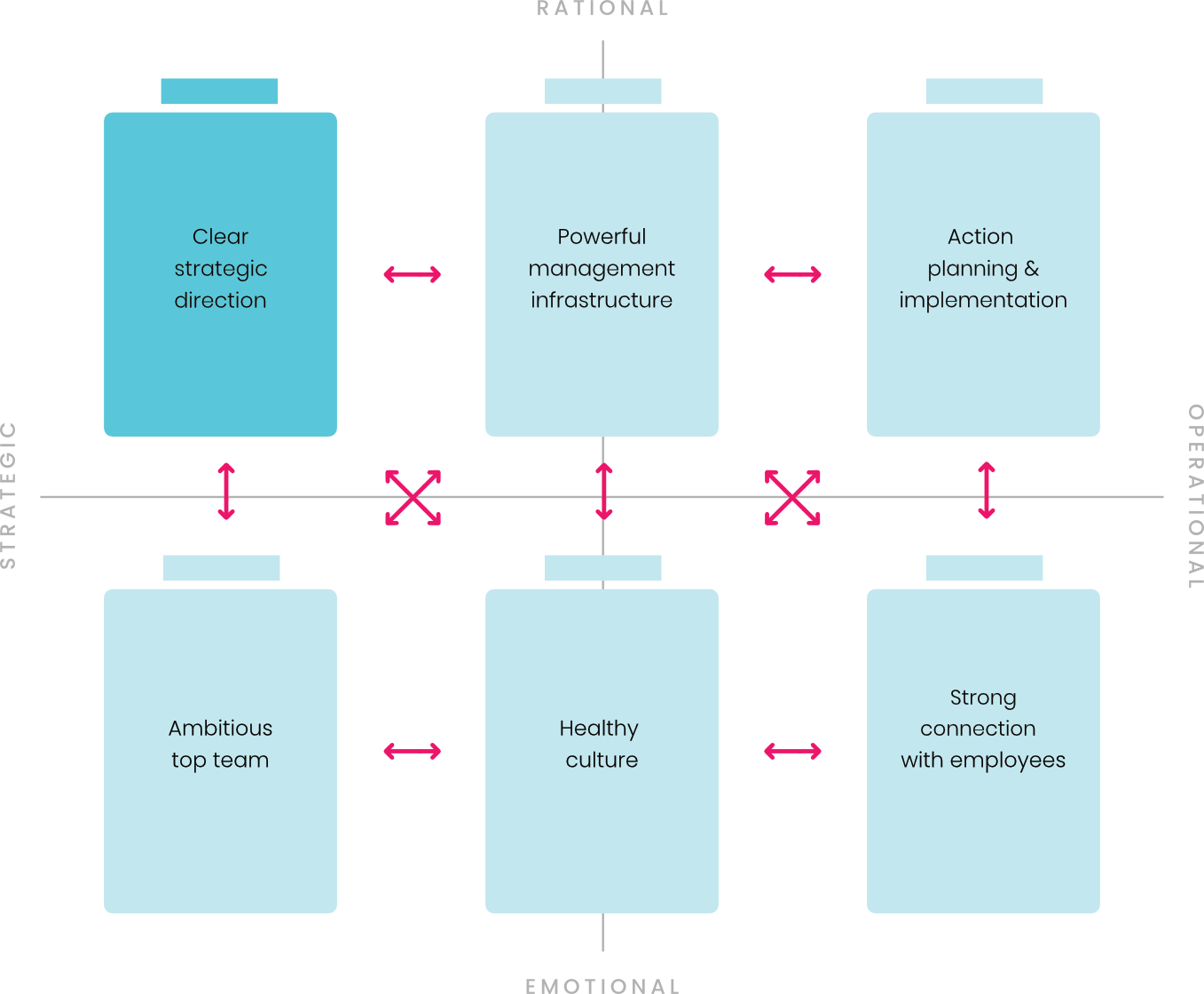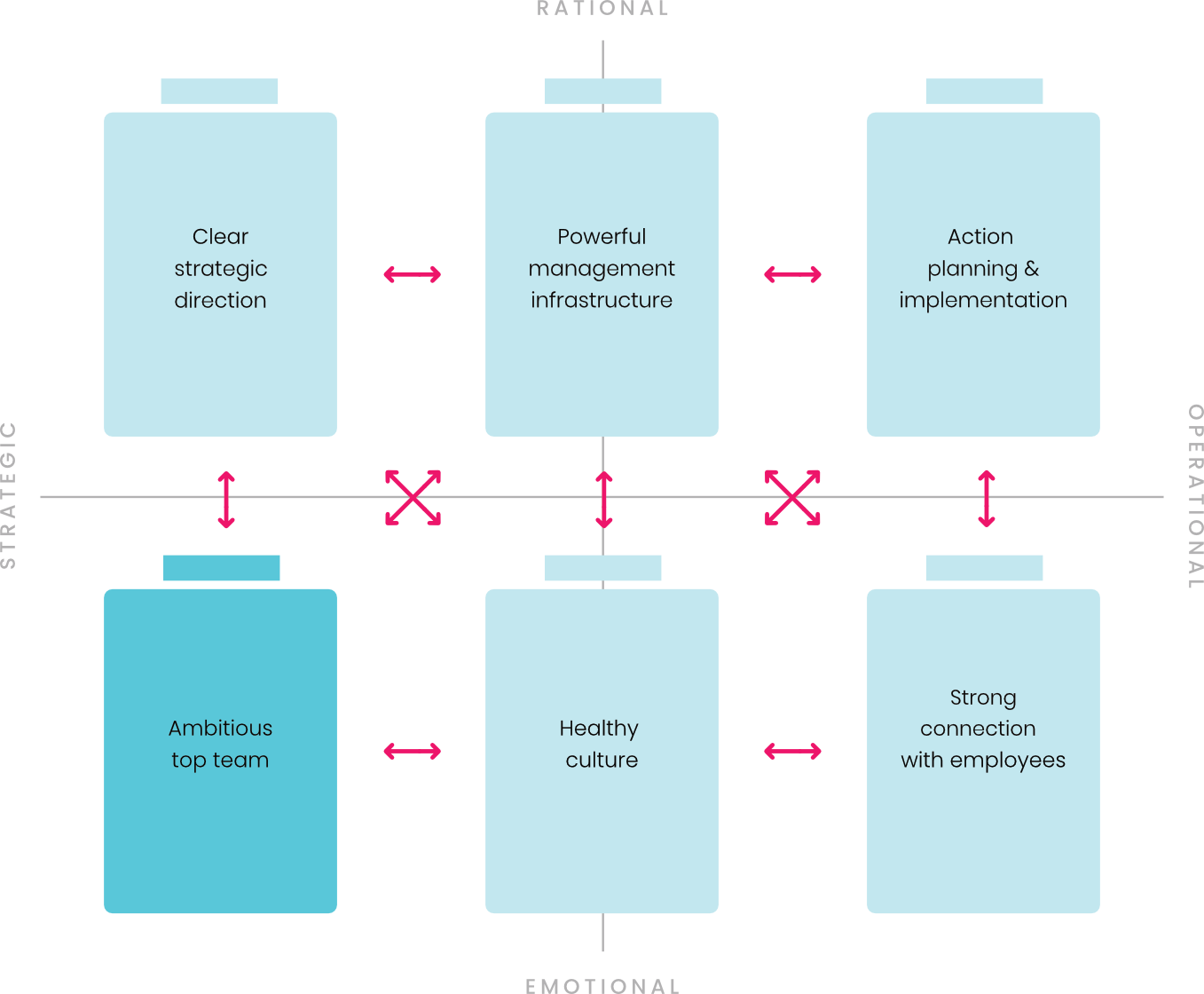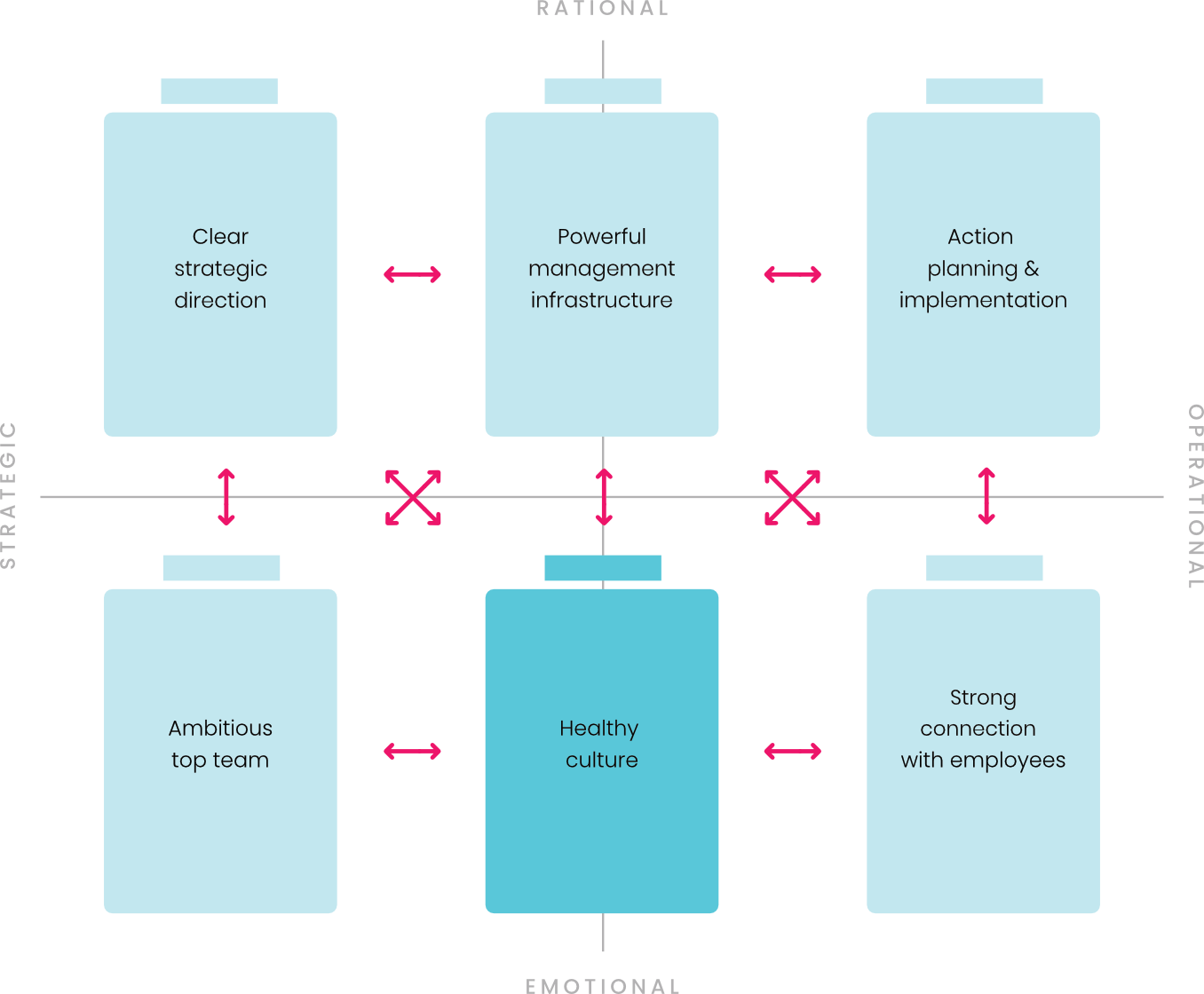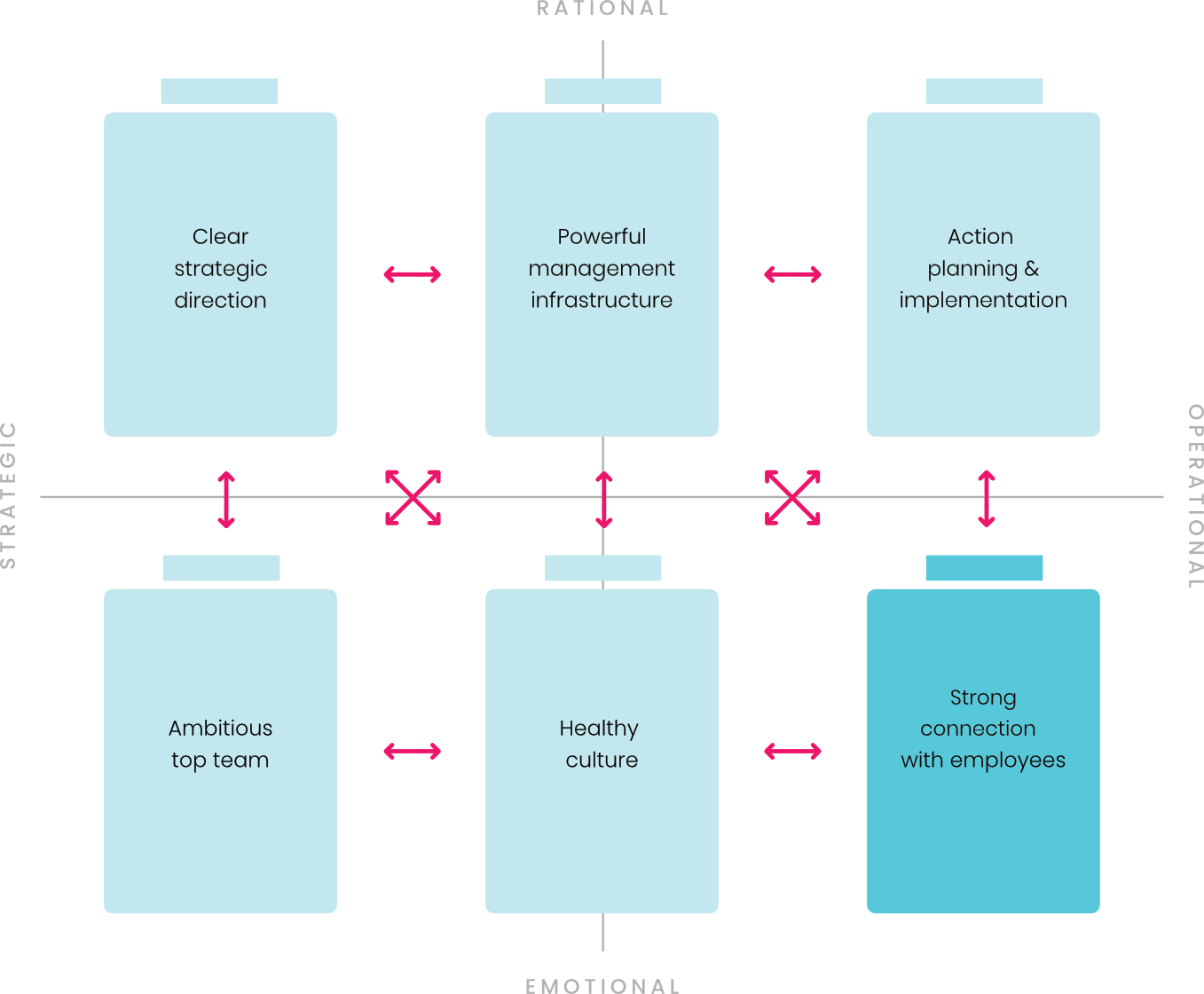Clear strategic direction
In a VUCA world organisations need to be smart. They have to be well aware of what is going on in their environment (strategy analysis), decide what to focus on (strategy formulation) but at the same time choose wisely how to set up strategic experiments to prepare for disruption (strategic experimentation).

All too often organizations don’t truly understand their customer’s needs or fail to distinguish themselves from their competitors. They develop strategies for each function (operations, marketing, R&D) but lack an overall strategy that articulates how the win in the market. This leads to confusion and lack of focus. Further, they often fail to see how technology disruptors are changing their business model. As a result, they are out of business before even realizing it.
1. Having departmental strategies but no overall organization strategy
2. Lacking knowledge about competitor moves or changing customer needs
3. Being blind for disruptors
1. Strategy Analysis: my current performance, my competitors, my customers, my future game
2. Formulating a clear strategy: what is your competitive arena and your competitive theme
3. Using strategy maps to define goals and success factors
Ambitious top team
In today’s world people want to be inspired. The most important source of energy to accomplish this is your top team battery. It drives change by setting an inspiring change ambition: senior leaders in your organization need to make sure people feel the heat but also see the light. They need to lead the way through collaboration and role modeling.

Unfortunately, many top teams don’t succeed to create a strong coalition of the willing. As a result, they lack a strong mandate for change from key stakeholders and neglect to allocate sufficient budgets and time for change. As they fail to assess the change capabilities of their organization, they often underestimate their role as change leaders. Without the support of senior leaders, profound change is almost impossible.
1. Top executives fail to serve as role models for change
2. Top managers fail to hold each other accountable for actions and communication
3. Failing to allocate sufficient time and budgets for change
4. Failing to periodically assess your change capabilities
1. Compelling transformation story
2. Building a top team using Lencioni
3. Periodically assessing the batteries of your organisation
Powerful management infrastructure
The powerful management infrastructure serves as a bridge between the strategy and the many projects that help to implement it. It includes the organisation’s structures, processes and systems that help managers to run the business while building it.

From all batteries, this is the one that almost all organisations struggle with. The absolute number one drainer in our database is linked to running too many initiatives in parallel. Organisations fail to define clear priorities for their projects and objectives and lack capacity management techniques that prevent their key employees to continuously operate in overdrive. As they lack an overview of what is going or spend their time on bureaucratic reporting, they often reinvent the wheel. They lack the systemic energy to balance change with stability management.
1. Dealing with operational issues leaves hardly any time for change management
2. Trying to implement too many projects concurrently
3. Lacking a Project Management office to smoothen alignment and reporting
1. Objectives – Key Results
2. Priority management & capacity matrix
3. Energy Room
Healthy culture
Culture can break or make your change programs. In social environments that are open, collaborative and receptive to new ideas, change is more likely to be successful than in unhealthy environments that are characterized by power distance, silo departments, and inside-out thinking.

Many organisations say they need cultural change or need to become agile but fail to articulate what they mean by this. They don’t measure their culture and as a result, they fail to build strong social ties based on values of the desired culture. As such they remain trapped in values that characterize command & control systems and top-down change approaches. One of the important paradigms here is that despites their control nature, these organisations often fail to link consequences to inappropriate behaviors and keep poor performing people on board.
1. Culture is a fluffy word: we never measure of assess our values
2. Change communication is a one-way top-down street
3. Keeping 'poor' people on board: performance and behavior without consequences
1. Measuring your culture
2. Nonviolent communication
3. Building tribal values
Action planning and implementation
Effective change gets things done. Sound process and project management translates strategy into actions that deliver breakthrough operational results and lasting customer benefits. This battery represents the second biggest challenge for most organisations.

It's not that organizations lack actions or to do lists. In fact, many are so overwhelmed by them that they fail to articulate WHY change projects are needed or fail to create to the conditions for success for their projects. They lack a healthy rhythm and methodology that builds on data and assures getting the right people on board. All too often they ignore the benefits of prototyping and experimentation. When they introduce the change, they fail to translate it into new routines that stick.
1. No rhythm - poor coordination and prioritization of actions
2. Quick fix solutions - poor use of data to understand the As Is situation
3. No experimentation or prototyping to assess the value and risks of potential solutions
1. Obtain a clear project mandate
2. Methodology essentials: Double Diamant – DAFRIM
3. Minimal viable practices of project management
Strong connection with employees
Organisations are made up of people. Asking people to change isn’t always easy. Some will be enthusiastic – many will resist before they embrace the change and the opportunities it brings. Effective change thrives on psychological energy that increases security and drives employee commitment.

Many organisations already start off on the wrong foot: their communication fails to create sufficient awareness or doesn’t provide enough room to explore the individual consequences of change. Effective resistance management invites people to experiment with the new change. It turns influence leaders into true ambassadors of change. Receiving positive feedback and stimuli from peers is often essential to avoid people returning to old behaviors.
1. Feeling the change but not knowing where it leads to
2. People easily return to old behaviors
3. Little to no leadership coaching on the floor
1. Commitment ladder
2. Resistance management
3. Viral change
